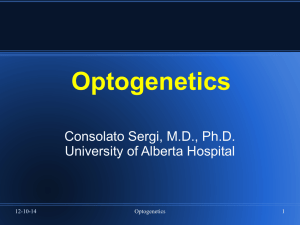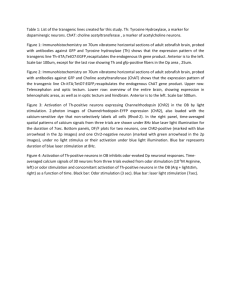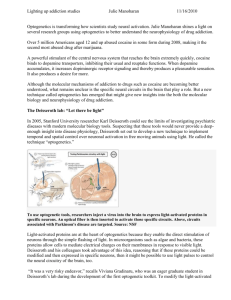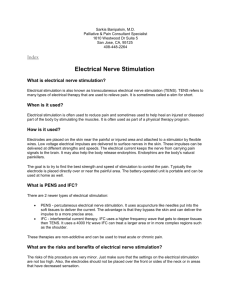Remote-controlled Humans: Manipulating the Brain and
advertisement
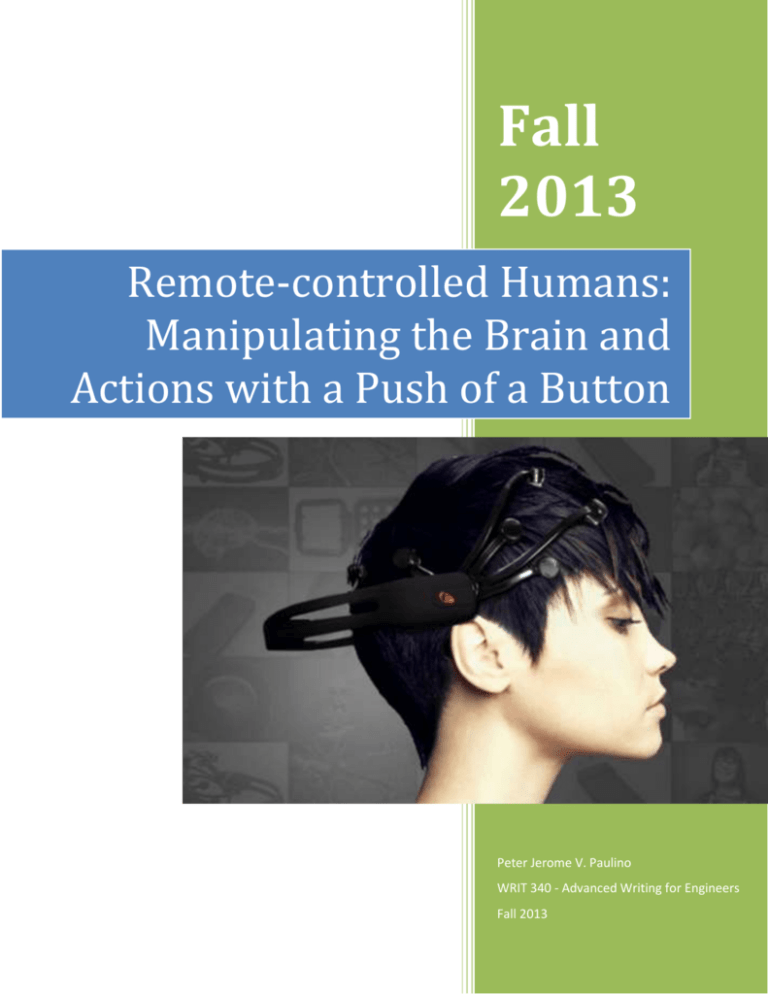
Fall 2013 Remote-controlled Humans: Manipulating the Brain and Actions with a Push of a Button Peter Jerome V. Paulino WRIT 340 - Advanced Writing for Engineers Fall 2013 Paulino 2 Peter Jerome V. Paulino Writing 340 – Advanced Writing for Engineers Professor Aubertin October 18, 2013 Remote-controlled Humans: Manipulating the Brain and Actions with a Push of a Button Like the CPU of a computer, the brain is the central processing center of the human body. The brain is where all the decision-making happens and controls every action that our organs and limbs do. It’s the main junction of all our functions, thoughts and, memories. The brain is made up of network of neurons integrated and working together. A neuron communicates with its neighboring neurons by electrical or chemical signaling [1]. Its constituency is essentially like the motherboard providing the electrical connections by which the other components of the system communicate. Therefore, this circuit connection can also be disrupted and manipulated by external signals that will alter the activity of the brain [1]. This can create remote- controlled human actions that are mind-boggling. Introduction Remote-controlled things are everywhere. Remote-controlled cars and helicopters can be seen in the playground while remote-controlled robots and space-arms can be seen in space floating around with the International Space Station assisting the astronauts. The idea and having the power to control a complex entity with a push of a button is thrilling and fascinating. Arguably, humans are the most complex and the smartest beings in the universe. Since existence, humans have conquered the world with their complex solving problem skills and innovative abilities. In reality, is it possible to control humans with a push of a button? Yes, that’s the answer that the advancement of neuroscience is giving. The brain activity relies on Paulino 3 connected and integrated interactions of neurons in the brain working like a circuit [1]. Every single aspect of human emotion, behavior, sensation, and perception is regulated by brain activity. Having the ability to stimulate brain function is therefore achievable and a very powerful technology. This technology can be applied to medicine and treat different types of neuromuscular diseases such as human motor skills disorder, epilepsy, and movement dysfunctions associated with Parkinson’s disease, Huntington’s disease, traumatic brain injury, stroke, etc. Brain Stimulation with Electrodes Electrode has been the main theme and technique used by neuroscientists to analyze and manipulate brain activity for the past 10 years. Researchers have contributed to this field with much precision and with much good intention. Studies have shown that brain stimulation is capable of treating neurological disorders and brain injury and controlling information processing in brain circuits [3]. Deep brain stimulation has been developed to treat neurological diseases such as Parkinson’s disease. This procedure is only used for patients with symptoms of neurological movement disorder that cannot be adequately controlled with medications. The Deep Brain Stimulation (DBS) is done by surgically implanting a neurostimulator that deliver electrical stimulation to intended areas in the brain that control movement (see Fig. 1) [3]. The DBS is considered to be cost-effective, offering a value for money profile comparable to other well accepted health care technologies [2]. Paulino 4 Figure 1. A medical procedure of the embedment of the Deep Brain Stimulation (DBS). Source: Wikipedia However, several limitations still pose significant challenges to implementing traditional brain stimulation methods for treating diseases and controlling information processing in brain circuits [3]. For example, DBS requires neurosurgery in order to implant electrodes and batteries into the patients and pose severe risks and complications. To overcome the limitations, a lab in Arizona State University has engineered an innovative technology which implements transcranial pulsed ultrasound which remotely and directly stimulate brain circuits without requiring surgery [3]. Furthermore, the study has shown this ultrasonic neuromodulation approach confers a fine resolution and can exert its effects upon subcortical brain circuits deep within the brain [3]. Math and the Brain Paulino 5 Researchers from Stanford University School of Medicine have discovered that a region in the brain activated when people are asked to solve mathematical problems is also triggered when people use numbers and quantitative terms in normal and everyday conversation. The team implies that their findings could lead to “mind-reading” devices that could allow a person to communicate through passive thinking or even lead to neuroimplants that could read or control a person’s thinking [4]. To research their findings, published in the Nature Communications journal, the researchers used a brain monitoring method called “intracranial recording” on three subjects who were being examined for potential surgical treatment for recurring, drug-resistant epileptic seizures. The procedure was done by temporarily detaching a part of the skull of the patient before placing packets of electrodes directly against the surface of the brain [4]. Then, the patients were monitored for about a week in the hospital while attached to the positioned electrodes which gathered any electrical activity happening on the patient’s brain [4]. This allowed the researchers to monitor the patient’s seizure and analyze precisely from what region of the brain they were originating from. The researchers emphasize that during this time, although mainly confined to a hospital bed, the patients were able to live their everyday life [4]. They were free to eat, drink, think, talk to friends and family, watch TV and most importantly were comfortable and pain free. This technique allowed them to monitor the brain activity of the subjects in a normal condition and when doing real-life activities, compared with the traditional methods of brain monitoring such as fMRI, which takes place in a controlled and unnatural environment [4]. During this experiment, the participants were asked to complete tests. These required true or false answers to Paulino 6 basic mathematical questions like, “is it true that 3+3=7?” as well as episodic memory questions, such as “is it true if I had soup for lunch?” Sometimes, the patients were asked to stare at a blank screen in order to record and determine the resting-state of their brain [4]. Analysis of the results of the subject’s daily electrode activity revealed activation spikes in the intraparietal sulcus which is the region of the brain that has an important role in attention as well as hand and eye movement [4]. The researchers also indicated that this area of the brain is involved in numerosity which they defined as the mathematical equivalent of literacy [4]. The team discovered that every time the subject said a number or quantitative reference, such as “some more” or “a lot”, this triggered the same electrical activity in neurons of the intraparietal sulcus as when patients were doing mathematical computations [4]. After the brain activity discovery, the researchers suggest that their results and findings open up the possibility of developing mind-control or mind-control reading devices. They propose that a person that became mute because of stroke may one day be able to communicate again through passive thinking. Human-to-human Brain Interface Perhaps, the most innovative and successful technology that can lead to controlling the information processes in the brain is the recent study done at the University of Washing ton. Researchers have performed what they believe is the first noninvasive human-to-human brain interface, with one researcher able to send a brain signal via the Internet to control the hand motions of a fellow researcher. They used electrical brain recordings and created a magnetic stimulation form, a subject sent a brain signal to another subject on the other side of the school’s campus, causing the finger to move on a keyboard [5]. This is a prime example of the beginning of a remote-controlled human. Paulino 7 The techniques applied to this research are well-known and popular in the field of neuroscience. They were Electroencephalography (EEG) which is commonly used by scientists to record the brain activity in specific regions (see Fig. 2) and the Transcranial magnetic stimulation which is a noninvasive method of delivering stimulation to the human brain to bring out a response. The response depends on where the coil is positioned and for this experiment; it was placed over the brain region which controls the person’s right hand [5]. The stimulation convinced the brain that it needed to move the right hand by activating the neurons in that area [5]. Figure 2. A patient on an Electroencephalography (EEG) which is used to record the brain activity in specific regions of the brain. Source: Wisconsin University Paulino 8 Researchers have done a brain-to-brain communication between two rats at Duke University and other researchers have conducted it between a human and a rat at Harvard University [5]. This is the first demonstration of human-to-human brain interfacing. Researcher Andrea Stocco implied that the Internet has networked humans by connecting computers, and now it can link humans by “connecting the brain” [5]. Optogenetics: Light-controlled Brain Optogenetics as it name entails is the combination of genetics and optics to control welldefined events within specific cells of living tissues [6]. It includes the discovery and insertion into cells of genes that confer light responsiveness; it also includes the associated technologies for delivering light deep into organisms as freely moving mammals [6]. Optogenetics is very specific compared to the electrodes that were once used. Electrodes tend control the whole region of a brain when it is activated while optogenetics can control specific areas of the brain that will contribute to the accuracy of controlling human actions in the future. The first study done with optogenetics is with a mouse (see Fig. 3). A gene from an alga was inserted to the mouse’s brain so they can response with light when activated. It was shockingly evident that the mouse was moving freely during normal condition but when the light was turned on, the mouse counter clockwise and its motor activity became remote-controlled [6]. Paulino 9 Figure 3. A laboratory mouse implanted with optogenetics. Source: University of Michigan Optogenetics has been used to control behavior of primates. This is a major milestone from the rat studies considering that humans are closely related to primates genetically [7]. The study done in Stanford University showed that monkeys respond to the light appearing to the screen faster when they had the optogenetic light inserted to their brain (about 0.20 milliseconds) suggesting that optogenetics can alter the behavior and vision response of primates [7]. After some years of development, optogenetic tools are rapidly reaching labs and universities all over the nation and are being applied to countless areas of biological and neuroscience research. Questions that were unanswered about depression, learning & memory, sleep, perception, etc. were addressed because of this technology. This proves that the techniques of optogenetic truly go with everything neuroscience-related. A study done by Alexxai Kravitz dealt specifically with Parkinson’s disease which affects the basal ganglia that other diseases also influence such as movement disorders associated with Tourette’s syndrome, obsessive compulsive disorder, schizophrenia, and addiction [7]. Using light to precisely change the activity of targeted neurons in the brain not only enhances our knowledge of how the brain Paulino 10 functions but also opens door for new therapeutic techniques and strategies in treating disorders [7]. The enthusiasm for optogenetics in neuroscience right now is strong. The hype surrounding these techniques has sometimes been a fast ticket into known and high-impact journals. Journals like the Cell, Nature, and Neuron which scientists have in their coffee table, office, or living room have a very high chance of having optogenetics as a topic. However, the field is quickly adapting and must soon reach a point where the researches that uses optogenetics are valued entirely for the science quality and the significance of the questions that are addressed. Epileptic Treatment through Brain Control Epilepsy seizures are caused by abnormal synchronization between brain regions and may lead to consciousness disturbance [8]. The diagnosis of epilepsy is typically made based on a description of the seizure and surrounding events. An electroencephalogram (EEG) can somehow aid in locating the focus of the epileptic seizure [8]. However, even though the mechanism of the spread is unclear, preventing this spread will help to control the seizure and improve patients’ lives. Amirkabir University researchers hypothesized that “controllability idea” which is the idea of driving the final state of a complex system like the brain to a desired one may aid in managing the behavior of brain as a biological network [8]. They utilized different neural concepts and applied the “complex network controllability” which requires the location of different driver nodes by using connectivity information such as the structural and anatomical organization of the brain [8]. This vast brain connectivity network information can be obtained from different neuroimaging techniques like diffusion tensor imaging (DTI) which is a type of Paulino 11 magnetic resonance imaging technique (MRI). DTI derived directed graphs and images are becoming increasingly available especially from clinical environments. The application of some brain simulation methods like the Trans-cranial Magnetic Stimulation (TMS) and Trans-cranial Direct Current Stimulation (TDCS) with brain connectivity networks data can be used in order to excite or inhibit the derived driver nodes by managing the brain’s abnormal states via driving them to normal ones and prevent the spread of asynchrony (see Fig. 4) [8]. Figure 4: A patient undergoing a Trans-cranial Magnetic Stimulation (TMS) procedure. Source: University of British Columbia Conclusion The 21st century is the era of the greatest advancements in the sciences. Neuroscience is in the front line offering innovative technologies and mind-boggling techniques no one can ever imagine. Truly, the brain is the most complex system in the universe and is the center of the greatest entity of the universe—man. Manipulating the brain and controlling human actions has never been this achievable with powerful techniques such as electrodes, ultrasounds, optogenetics, etc. and this ability can lead to treatment of epilepsies and disabilities involving motor dysfunctions. It’s really hard to imagine that we’re still in the early days with this Paulino 12 technology. If this is a football game, we’re not even in the first quarter. Instead, we just got a ticket to enter the stadium. References [1] NIH. (2013, March 20). “Brain Basics: Know Your Brain.” Internet:http://www.ninds.nih.gov/disorders/brain_basics/know_your_brain.htm [Oct. 1, 2013] [2] Dams, J., et al. (June 28, 2013). “Cost-effectiveness of deep brain stimulation in patients with Parkinson's disease.” Movement Disorder Society. 763-771. Available: http://www.ncbi.nlm.nih.gov/pubmed/23576266 [Oct. 7, 2013]. [3] Armed with Science. (2010, September 1). “Remote Control of Brain Activity Using Ultrasound.” Internet: http://science.dodlive.mil/2010/09/01/remote-control-of-brain-activityusing-ultrasound/ [Oct. 1, 2013]. [4] Dastjerdi, Mohammad., et al. (October 15, 2013). “Numerical processing in the human parietal cortex during experimental and natural conditions.” Nature Communications. 110-125. Available: http://www.nature.com/ncomms/2013/131015/ncomms3528/full/ncomms3528.html [Oct. 1, 2013]. [5] Washington. (August 27, 2013). “Researcher Controls Colleague’s motions in 1st Human Brain to Brain Interface.” Internet: http://www.washington.edu/news/2013/08/27/researchercontrols-colleagues-motions-in-1st-human-brain-to-brain-interface/ [Oct. 7, 2013]. [6] Cobolt. (2010). “Laser for Optogenetics.” Internet: http://www.cobolt.se/optogenetics.html [Oct. 7, 2013]. Paulino 13 [7] Kravitz, Alexxai, et al. (October 15, 2013). “Regulation of parkinsonian motor behaviours by optogenetic control of basal ganglia circuitry.” Nature. 622-626. Available: http://www.nature.com/nature/journal/v466/n7306/full/nature09159.html [Oct. 1, 2013]. [8] Bakouie, Fatemeh, et al. (December 12, 2013). "Managing epilecptic seizures by controlling the brain driver nodes: a complex network view." Frontiers in bioengineering and biotechnology. 1-2. Available: http://www.readcube.com/articles/10.3389/fbioe.2013.00021?locale=en [Dec. 15, 2013].
